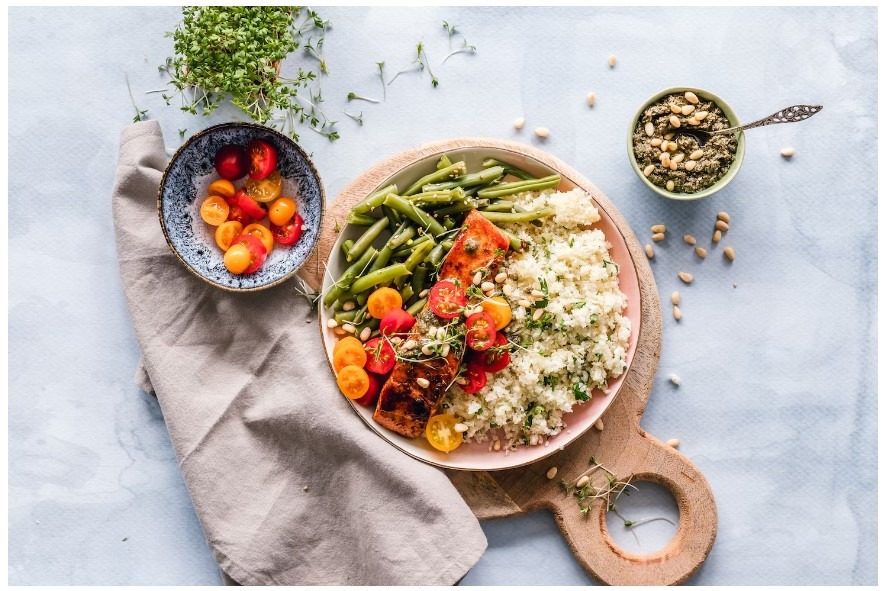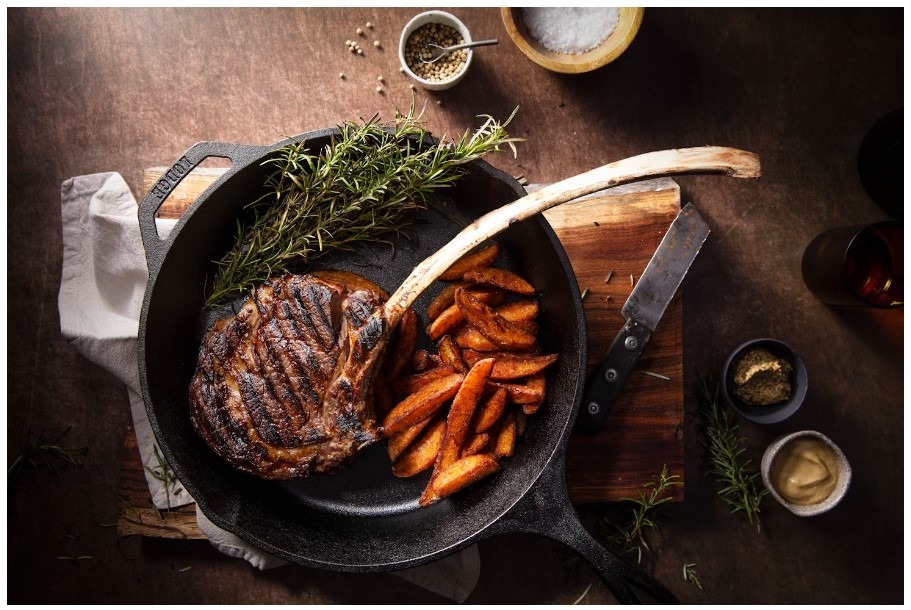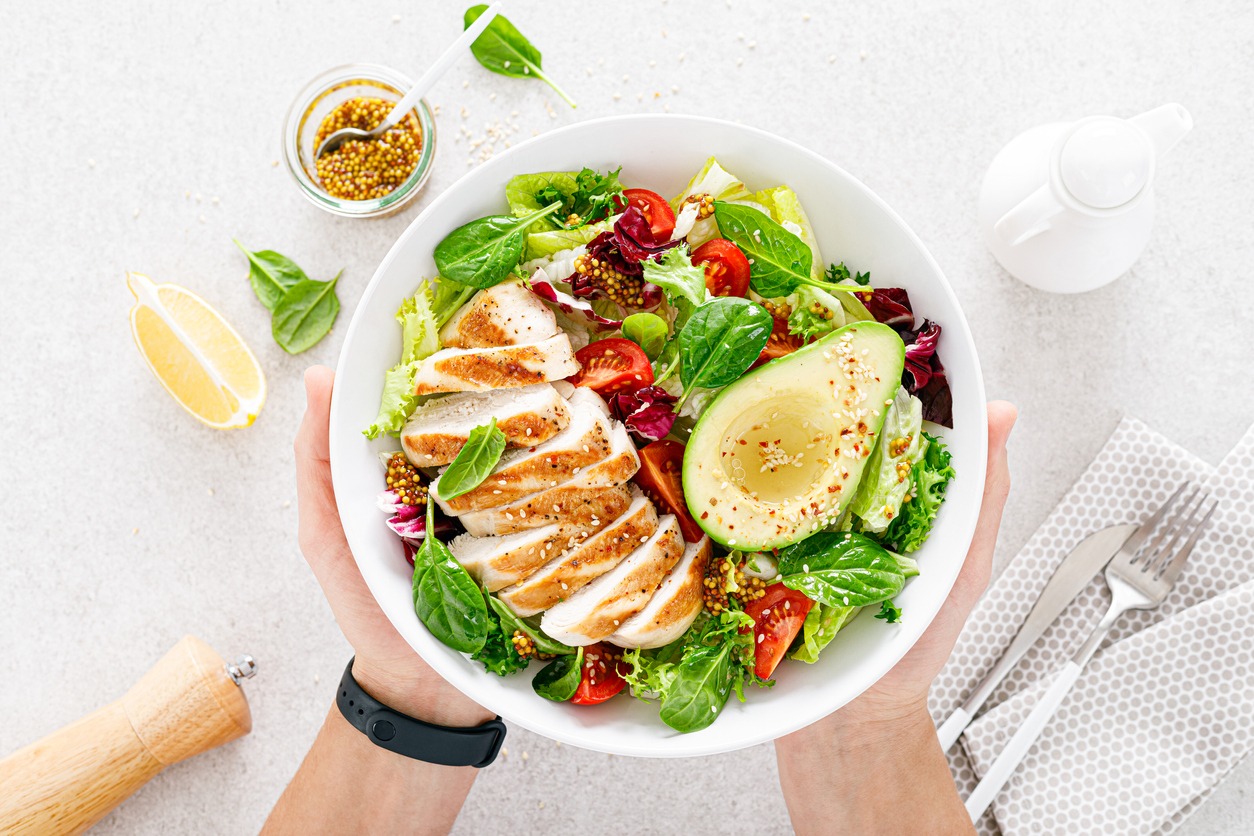Among the low-calorie diets, the 1800-calorie diet when well planned, is the one that produces weight loss in most overweight diabetic persons or nondiabetic active persons without feeling deprived while providing all the needed nutrients and vitamins. Losing weight requires eating fewer calories daily than you burn. However, a calorie-controlled diet should include a variety of foods from each food group to ensure that you are covering all your nutritional needs. It should also be easy to follow without starving. The 1800-calorie meal plan fulfills these requirements.
For whom is this diet plan generally indicated
– Overweight diabetic patients. It is recommended by the American Diabetic Association (ADA). That is why it is often referred as 1800-calorie diabetic diet or ADA diet.
– Nondiabetic persons requiring a low-calorie diet.
– Large framed active women that want to lose weight.
– Medium framed active or large framed sedentary/lightly active men looking to lose weight.
– Men and women with obesity or overweight, especially if it is accompanied by hyperlipidemia, high blood pressure (hypertension) in the presence of one or more risk factors for cardiovascular disease, obstructive sleep apnea syndrome (OSAS), glucose intolerance, diabetes mellitus (DM) type 2 (type 2 diabetes), spinal disease, osteoarthritis.
Objectives of this diet
– Achieving a reasonable weight in order to reduce morbidity and mortality associated with obesity and obtain an improvement in the quality of life.
– Provide a minimum of energy, preserving a contribution of macronutrients and micronutrients to prevent potentially dangerous loss of lean body mass.
Dietary recommendations
In weight reduction and maintenance, it is not only important to control energy intake but also the distribution of this energy throughout the day and especially the composition in macronutrients of the diet (carbohydrates, proteins, and fats). Try to consume more than four meals a day, trying to make a hearty breakfast and a light dinner. Several studies indicate that it is easier to lose weight with this caloric distribution. We suggest the following:
– Breakfast and midmorning: should provide 25% of total calories
– Lunch: should provide about 35-40%
– Snack: should provide 15%
– Dinner: the remaining 20-25%.
As for the macronutrients distribution:
– Carbohydrates (mainly complex) should provide more than 55% of the total energy the diet.
– Protein should provide 10-15% of total calories.
– Fats should not provide more than 25-30% of total energy.
– Carbohydrates (55%) = 990 kcal / 3.75 kcal = 264 g
– Protein (15%) = 270 kcal / 4 kcal = 67.5 g
– Fat (30%) = 540 kcal / 9 kcal = 60 g
Note that:
– 1 g of carbohydrates = 3.75 – 4 kcal
– 1 g protein = 4 kcal
– 1g fat = 9 kcal
What to consume
– Milk and dairy products (preferably fortified with calcium and vitamin D): skim milk, nonfat dairy products, desserts made with skim milk and calorie-free sweeteners (saccharin, aspartame).
– Cereals, legumes, and tubers: foods in this group are included in the diet as they represent the main contribution of carbohydrates and vegetables also provide protein, vitamins, minerals, and fiber.
– Bread: can be white, although the whole is recommended, not because it contains fewer calories, but because it features more fiber that prevents constipation and can produce greater satiety.
– Vegetables: as they are low-calorie-density foods, most vegetables can be included in increased amounts. It is necessary to encourage their consumption, insisting that once a day, they are in the diet as raw (salads, dressings).
– Fruits: consume 2-3 pieces a day. A citrus fruit is recommended. Try taking them fresh and raw, stewed or not prepared.
– Meat, fish, and eggs:
* Give preference to lower-fat meats like chicken, turkey, rabbit, pork loin or tenderloin or beef (always remove visible fat).
* Increase consumption of fish, preferably white (sole, cod, haddock, flounder) because of their lower fat content. However, dark fish should also be consumed because while richer in fat, they are a major source of omega-3 fatty acids. Intake up to 4 servings of fish per week.
– Fats and oils: as they play an important role in both the nutritional and organoleptic aspect, they must be present in all diets. Extra virgin olive oil is recommended.
– Noncaloric sweeteners: saccharin (while a subject of controversy, has been proven to be safe by numerous studies) and aspartame, approved by the FDA, among others, are recommended. This does not mean you cannot use sugar in this diet but limit it.
5-day menu ideas of 1,800 calories
Monday
| Breakfast | 1 cup of skim or low-fat milk with 2 slices of bread with 1 tablespoon olive oil and tomato. |
| Mid-morning | 1 cup fresh fruit salad with 10 almonds. |
| Lunch | 1 bowl of pasta (70 grams dry) with broccoli, 100 grams of chicken breast, carrot and 3 tablespoons corn kernels seasoned with 3 tablespoons low-fat cream cheese. 1 cantaloupe for dessert. |
| Snack | 1 cup of nonfat yogurt with 30 grams of oatmeal and fresh cherries. |
| Dinner | Lettuce salad, 100 grams of tuna, cherry tomatoes, yellow pepper, 1 egg, and carrot flavored with lemon juice, salt and a tablespoon of olive oil. 1 peach for dessert. |
Tuesday
| Breakfast | 1 cup of nonfat yogurt with 50 grams of oats, 5 walnuts, and 1 banana slices. |
| Mid-morning | Infusion and 1 slice of bread with 1 tablespoon low-fat cream cheese. |
| Lunch | Sauteed bottom round steak and rice prepared with 1 cup cooked rice, 100 grams of bottom round steak, zucchini, carrot, onion and a tablespoon of olive oil. 1 cup of watermelon for dessert. |
| Snack | 1 cup of skim milk 1 slice of bread with 1 tablespoon low-calorie jam. |
| Dinner | Pork and vegetable kabobs made with 100 grams of pork sirloin or pork loin, eggplant, tomato, red pepper, and onion. 1 nectarine for dessert. |
Wednesday
| Breakfast | 1 cup of skim milk with a sandwich of wholemeal bread, feta cheese, tomato, and lettuce. |
| Mid-morning | 1 cup of yogurt 1 kiwi pieces and 10 almonds. |
| Lunch | Shrimp lentil avocado salad made with 1 cup of cooked lentils, 100 grams of shrimp, 1/2 avocado, lemon juice, 3 tablespoons corn kernels and tomato. 1 banana for dessert. |
| Snack | Tea or coffee with 2 slices of bread with 3 tablespoons reduced-calorie jam. |
| Dinner | 100 grams of chicken breast grilled with pumpkin puree seasoned with 1 tablespoon olive oil. 1 apple for dessert. |
Thursday
| Breakfast | 1 cup of skim milk with 2 slices of bread with 1 tablespoon olive oil and tomato. |
| Mid-morning | Smoothie made with 1 cup of skim milk and 1 banana. |
| Lunch | Beef potato baby corn salad made with 1 large potato, 100 grams of lean beef, baby corns, tomatoes and red onions seasoned with 1 tablespoon olive oil and lemon juice. 1 cup of apricots for dessert. |
| Snack | 1 glass of fresh orange juice with 2 slices of bread with 2 tablespoons low-fat cream cheese and 1 tablespoon of flax seed. |
| Dinner | 100 grams of Hake en papillote accompanied with beet salad and 1 egg seasoned with 2 tablespoons low-fat cream cheese. 1 pear for dessert. |
Friday
| Breakfast | Tea or coffee, 1 sandwich of wholemeal bread with 1 slice of cheese and 50 grams of turkey breast. |
| Mid-morning | 1 cup of low-fat yogurt with fresh cherries and 6 nuts. |
| Lunch | 150 grams of chicken breast baked with onions and peppers accompanied with 1 cup of cooked quinoa with green pepper, onion, and chopped tomatoes, seasoned with 1 tablespoon olive oil. 1 cantaloupe for dessert. |
| Snack | 1 cup of skim milk 1 slice of bread with 2 tablespoons reduced-calorie jam. |
| Dinner | Zucchini scrambled eggs made with 2 eggs, zucchini, tomatoes, and onion. 1 cup of apricots for dessert. |
By controlling portions and choosing low-calorie-density foods, you can achieve a healthy meal plan providing all the nutrients and balance the body needs to function healthily. This menu will help you to lose weight in a healthy way. It is important to choose calorie-free drinks like water so that you don’t exceed the caloric intake of the diet.




